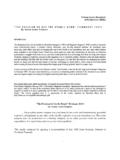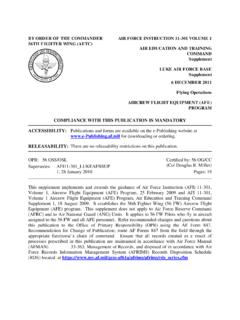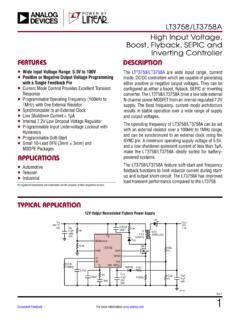Transcription of BY ORDER OF THE AIR FORCE INSTRUCTION 11 …
1 BY ORDER OF THE SECRETARY OF THE AIR FORCE AIR FORCE INSTRUCTION 11-301, Volume 3 1 FEBRUARY 2016 Flying Operations AIRCREW FLIGHT EQUIPMENT (AFE) CONTINGENCY OPERATIONS COMPLIANCE WITH THIS PUBLICATION IS MANDATORY ACCESSIBILITY: Publications and forms are available on the e-Publishing website at for downloading or ordering. RELEASABILITY: There are no releasability restrictions on this publication. OPR: AF/A3OI Certified by: AF/A35 (Maj Gen Martin Whelan) Pages: 21 This volume implements Air FORCE Policy Directive (AFPD) 11-3, Aircrew Flight Equipment, and compliments AFI 11-301, Volume 1, Aircrew Flight Equipment (AFE) Program. It directs the management of US Air FORCE (USAF), Air National Guard (ANG) and Air FORCE Reserve Command (AFRC) AFE personnel (to include DOD and contract civilians) and describes objectives, responsibility, and operations in support of contingencies in a deployed environment.
2 It specifies minimum administrative, procedural and operational performance and management standards for services provided by all USAF AFE facilities, including USAF contracted AFE locations where the USAF has functional oversight responsibility. This publication may be supplemented at any level, but all direct supplements must be routed for coordination prior to certification and approval to the OPR of this publication and HQ AFE SharePoint checklists, HQ USAF/A3OI. Send comments and suggested improvements to this INSTRUCTION on an Air FORCE (AF) Form 847, Recommendation for Change of Publication, through the chain of command, in accordance with (IAW) Air FORCE INSTRUCTION (AFI) 33-360, Volume 1, Publications and Forms Management, to HQ USAF/A3OI, 1480 Air FORCE Pentagon, Washington DC 20330-1480.
3 The authorities to waive wing/unit level requirements in this publication are identified with a Tier ( T-0, T-1, T-2, and T-3 ) number following the compliance statement. See AFI 33-360, Publications and Forms Management, for a description of the authorities associated with the Tier numbers. Requests for waivers must be submitted through the chain of command to the appropriate Tier waiver approval authority. Intervening levels will evaluate all recommendations and forward the AF Form 847 to the next echelon. Ensure that all records created because of processes prescribed in this publication are maintained IAW Air FORCE Manual (AFMAN) 33-363, Management of Records, and disposed of IAW the 2 AFI11-301V3 1 FEBRUARY 2016 Air FORCE Records Disposition Schedule (RDS) located in the Air FORCE Records Information Management System (AFRIMS).
4 The use of the name or mark of any specific manufacturer, commercial product, commodity, or service in this publication does not imply endorsement by the Air FORCE . AFI11-301V3 1 FEBRUARY 2016 3 Chapter 1 OVERVIEW Mission. Provide a safe and effective Aircrew Flight Equipment (AFE) Contingency Operations program. Protect and sustain the lives of aircrew members and AFE personnel during contingency operations. Program Objectives: Develop and prepare Aircrew Flight Equipment Superintendents (AFES), supervisors and technicians, to support, conduct, and sustain operations during exercises and real world contingencies. Aid in preparation, deployment, employment, and recovery of personnel and equipment to support the full range of operational environments.
5 Operational Environment An operational environment (OE) is a compilation of interrelated conditions, circumstances, and influences that affect the employment of capabilities and bear on decisions. An assessment of the OE consists of a detailed analysis of the aircrew chemical, biological, radiological, and nuclear (ACBRN) threats and hazards and the political, military, economic, social, information, infrastructure, physical environment and time (PMESII-PT) variables. Threat and Hazard Assessments are used to assist commanders and planning functions in determining what threats or hazards may be faced at an installation or a deployed location.
6 PMESII-PT is a joint systems approach that allows commanders, planners, and support staff to understand the OE. The PMESII-PT variables provide a framework for understanding, characterizing, and managing ACBRN threats and hazards specific to an OE. It is imperative that AFE personnel understand the OE to ensure proper equipment is deployed and postured appropriately to support AFE and customer needs. Unit Intelligence activities provide the proper resources to gain this knowledge needed to support deployed operations. When deploying into a CBRN area or OE refer to AFMAN 11-301, Aircrew Flight Equipment (AFE) Operations in a Chemical, Biological, Radiological, and Nuclear (CBRN) Environment.
7 Communications: All subordinate units will ensure AFE matters, including requests for waivers and any other communications are accomplished IAW AFI 11-301, Volume 1, Aircrew Flight Equipment (AFE) Program. (T-2) Access to an organizational and/or individual secure internet protocol router (SIPR) account is required for the AFE superintendent to respond to classified correspondence (home station and deployed locations). (T-2) 4 AFI11-301V3 1 FEBRUARY 2016 Units will periodically check the HQ USAF/A3OI SharePoint and their respective MAJCOM SharePoint to ensure receipt of all applicable information. (T-2) AFI11-301V3 1 FEBRUARY 2016 5 Chapter 2 RESPONSIBILITIES Shared Responsibilities.
8 See AFI 11-301, Volume 1, AFI 11-301, Volume 2, Maintenance and Configuration Requirements for Aircrew Flight Equipment (AFE) and AFMAN 11-301, for additional responsibilities. Director of Future Operations (HQ USAF/A35) through Total FORCE Integration Division (HQ USAF/A3OI). Approve new AFE Unit Type Codes (UTC). See AFI 11-301, Volume 1, for additional responsibilities. MAJCOM/A3Ts and ANG/A3Ts or equivalent: Establish command-specific supplement (if required) and route to HQ USAF/A3OI. Review Operation Plans (OPLANs), AFI 10-201, Status Of Resources And Training System, and AFI 10-401, Contingency Plans Management, requirements. Ensure standardized guidance is provided to the maximum extent possible for mobility and ACBRN operations at bare-base and unit-exercise locations.
9 Expeditionary Group (EG) Commander or ARC Equivalent: Ensure an AFE QA program is established IAW AFI 11-301, Volume 1. (T-2) Ensure AFE facilities meet standards in AFI 32-1024, Standard Facility Requirements, and AFH 32-1084, Facility Requirements. Ensure all AFE items are stored/maintained within approved AFE facilities and IAW applicable technical data. (T-2) Ensure AFE personnel are available to perform mission-essential duties to sustain AFE operations ( , AFE issue, fitting and inspection, aircraft-installed AFE configurations, pre-deployment AFE briefings, Aircrew Contamination Control Area (ACCA) operations, flight equipment contamination mitigation, etc.)
10 Ensure AFE personnel are not assigned duties that will detract from wartime proficiencies and requirements. These requirements also apply to Inspector General Exercises (IGX), Operational Readiness Exercises (ORE), Mobility Exercises (MOBEX), Readiness Assistance Visits (RAV), and generation exercises as AFE skill sets are critical to contingency operations. (T-2) Ensure standardized guidance is provided for aircraft and AFE configurations, mobility and ACBRN operations at bare-base and unit exercise locations. Standardized guidance will be provided to the maximum extent possible. (T-2) Ensure AFE functions are advised of changes to applicable contingency plans and operations in time to ensure required equipment is available for use during deployment.















